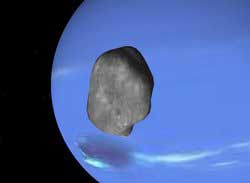.
Thalassa
Thalassa (pronounced /θəˈlæsə/ thə-LASS-ə, or as in Greek Θάλασσα), also known as Neptune IV, is the second innermost satellite of Neptune. Thalassa was named after a daughter of Aether and Hemera from Greek mythology. "Thalassa" is also the Greek word for "sea".
Thalassa was discovered sometime before mid-September, 1989 from the images taken by the Voyager 2 probe. It was given the temporary designation S/1989 N 5.[6] The discovery was announced (IAUC 4867) on September 29, 1989, but the text only talks of "25 frames taken over 11 days", giving a discovery date of sometime before September 18. The name was given on 16 September 1991[7].

A simulated view of Thalassa orbiting Neptune.
Thalassa is irregularly shaped and shows no sign of any geological modification. It is likely that it is a rubble pile re-accreted from fragments of Neptune's original satellites, which were smashed up by perturbations from Triton soon after that moon's capture into a very eccentric initial orbit.[8] Unusually for irregular bodies, it appears to be roughly disk-shaped.
Since the Thalassian orbit is below Neptune's synchronous orbit radius, it is slowly spiralling inward due to tidal deceleration and may eventually impact Neptune's atmosphere, or break up into a planetary ring upon passing its Roche limit due to tidal stretching. Relatively soon after, the spreading debris may impinge upon Despina's orbit.
Notes
1. ^ Surface gravity derived from the mass m, the gravitational constant G and the radius r: Gm/r2.
2. ^ Escape velocity derived from the mass m, the gravitational constant G and the radius r: √2Gm/r.
References
1. ^ Planet Neptune Data http://www.princeton.edu/~willman/planetary_systems/Sol/Neptune/
2. ^ R.A. Jacobson and W.M. Owen Jr. (2004). "The orbits of the inner Neptunian satellites from Voyager, Earthbased, and Hubble Space Telescope observations". Astronomical Journal 128: 1412. doi:10.1086/423037. http://adsabs.harvard.edu/cgi-bin/nph-bib_query?bibcode=2004AJ....128.1412J&db_key=AST&data_type=HTML&format=&high=444b66a47d15839.
3. ^ a b E. Karkoschka (2003). "Sizes, shapes, and albedos of the inner satellites of Neptune". Icarus 162: 400. doi:10.1016/S0019-1035(03)00002-2. http://adsabs.harvard.edu/cgi-bin/nph-bib_query?bibcode=2003Icar..162..400K&db_key=AST&data_type=HTML&format=&high=444b66a47d11635.
4. ^ Williams, Dr. David R. (2008-01-22). "Neptunian Satellite Fact Sheet". NASA (National Space Science Data Center). http://nssdc.gsfc.nasa.gov/planetary/factsheet/neptuniansatfact.html. Retrieved 2008-12-13.
5. ^ a b c d "Planetary Satellite Physical Parameters". JPL (Solar System Dynamics). 2008-10-24. http://ssd.jpl.nasa.gov/?sat_phys_par. Retrieved 2008-12-13.
6. ^ IAUC 4867 discovery IAUC circular
7. ^ "IAU Circular No. 5347". September 16, 1991. http://www.cfa.harvard.edu/iauc/05300/05347.html. Retrieved 2007-04-10.
8. ^ D. Banfield and N. Murray (1992). "A dynamical history of the inner neptunian satellites". Icarus 99: 390. doi:10.1016/0019-1035(92)90155-Z. http://adsabs.harvard.edu/cgi-bin/nph-bib_query?bibcode=1992Icar...99..390B&db_key=AST&data_type=HTML&format=&high=444b66a47d03051.
External links
* Thalassa Profile by NASA's Solar System Exploration
* Neptune's Known Satellites (by Scott S. Sheppard) * Naiad Profile by NASA's Solar System Exploration
* Neptune's Known Satellites (by Scott S. Sheppard)
Retrieved from "http://en.wikipedia.org/"
All text is available under the terms of the GNU Free Documentation License

